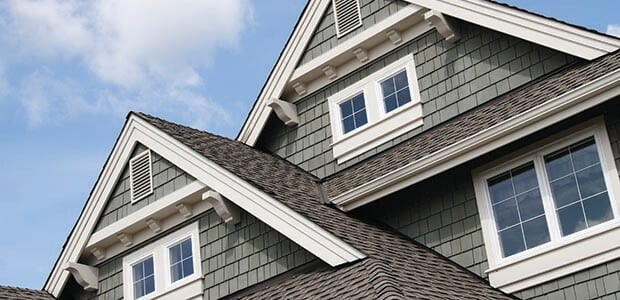 Algae Discoloration: Roof discoloration caused by the growth of algae. Also referred to as fungus growth.
Algae Discoloration: Roof discoloration caused by the growth of algae. Also referred to as fungus growth.
Asphalt Cement: An asphalt based adhesive material that is applied during the roofing process to bond roofing materials and seal the roof against the weather.
Asphalt Shingles: Any roofing shingle in which an asphalt waterproofing agent is applied during manufacture.
Back Surfacing: A fine layer of mineral material applied to the backside of shingles to keep them from sticking.
Base Flashing: Flashing attached to the decking surface in order to guide water flow onto the roofing material.
Blisters: Surface bubbles that appear on asphalt roofing after installation.
Built-up Roof: Any flat or low sloped roof that has been built up with multiple layers of asphalt and plywood sheeting.
Bundle: A package of shingles. It usually takes three to four bundles to cover a square (100 square feet) of roof.
Butt Edge: The bottom edge of a shingle.
Caulk: The process of filling a joint with asphalt cement or other caulking material to prevent leaks.
Cedar Shingles or Shakes: Wood shingles made of either rough hewn or sawn red cedar.
“Class A”: The highest rating for fire-resistance offered to roofing, able to withstand severe exposure from fire outside the building.
“Class B”: Roofing rating that indicates the material is able to withstand moderate exposure from fire outside the building.
“Class C”: Roofing rating that indicates the material is able to withstand light exposure from fire outside the building.
Composition Shingles: Shingles made from a variety of composite materials manufactured to resemble everything from wood shake shingles to ceramic tile.
Concealed Nail Method: Application method of roll roofing in which all the nails are covered by a cemented, overlapping course of shingles, thus hiding the nails from weather.
Course: Any row of shingles or other roofing material that runs the length of the roof.
Coverage: Refers to the weather protection provided by roofing materials based on the number of layers applied (i.e. single coverage, double coverage, etc).
Deck: Any surface to which roofing material is applied.
Dormer: A framed window that projects from the slope of the roof.
Double Coverage: Application method in which two layers of roofing material are achieved by lapping the shingles so that the lapped portion is at least two inches wider than the exposed area of the roofing.
Downspout: Any stretch of pipe that serves the purpose of draining water from roof gutters.
Drainage: A system of drainpipes and gutters that carry water away from a house’s foundation.
Drop Outlet: Piece of gutter that provides the hole through which water travels from the gutter to the drainpipes or storage tanks.
Eaves: The lower edge of a sloped roof.
Eaves Flashing: An extra layer of roofing applied at the eaves to prevent water damage in case of back-up.
Eaves Gutter: Any gutter attached to an eave overhang.
Edging Strips: Boards nailed along the eaves and rakes to provide a workable edge for re-roofing with asphalt shingles over pre-existing wood roofing material.
End Cap: The piece of formed plastic that is placed on the end of a section of gutter.
Exposed Nail Method: Method of applying roll roofing in which the nails are driven into an already cemented, overlapping course of roofing, leaving the nails exposed to the weather.
Fall: The slope of a stretch of gutter measured in the ratio of the vertical rise to horizontal distance.
Felt: Fibrous material treated with asphalt that is laid down as a sheathing paper before applying shingles.
Flashing: A layer of sheet metal laid down around vent pipes, adjoining walls, dormers, valleys and chimneys in order to prevent water from penetrating the home.
Gable: The triangular end of a home between the eaves and the ridgeline of the roof
Gauge: Refers to the thickness of a gutter. The optimal gauge for gutter is .032 inches.
Gutter: A trough that catches and channels water from the eaves to the downspouts.
Hanger: A flat strap of material that is applied under the roofing material in order to hold the gutter in place.
Head Lap: In triple coverage roofing the head lap is the shortest distance from the butt edge of an overlapping shingle to the upper edge of the shingles in the course below.
HEX Shingles: Shingles that take on a hexagonal appearance after installation.
Hip: The angle formed by two intersecting, sloping roof planes that runs from the eaves to the ridge of a house.
Interlocking Shingles: Shingles that fasten together to increase wind resistance.
Laminated Shingles: Shingles that are made of more than one layer of roofing material in order to create extra thickness.
Lap: The process of covering one course of shingles or roll with another.
Leader: Any pipe that carries water from the gutters to the ground, sewer or to a well.
Mineral-surfaced Roofing: Asphalt shingles or roll roofing covered with mineral granules.
Nesting: The process of laying new asphalt shingles over old shingles so that the top edge of the new shingle is butted up against the bottom edge of the existing shingles.
Offset: A pipe that redirects a downspout from the gutter under the eaves towards the house, and then down a wall.
Overhang: The portion of the roof that extends beyond the walls of a home. The soffit or eave is the underside of an overhang.
Pitch: The degree of the incline of a roof measured as the ratio between the rise of the roof to the span of the roof in feet.
Ply: The number of layers of roofing (i.e. one-ply, two-ply, etc).
Ponding: The pooling of water on a roof.
Racking: The process of applying shingle courses vertically as opposed to the more tried and true method of applying them horizontally and then up.
Rake: The inclined edge of a sloped roof over a wall.
Ridge: The uppermost angle of a roof created where two slopes of roof meet.
Rise: The vertical distance from the ridge line down to the eaves.
Roll Roofing: Asphalt roofing products that come in a roll as opposed to individual shingles.
Run: Half of the horizontal distance from a point directly under the ridge of the house down to the eaves. With gutters a run refers to any horizontal length of gutter.
Self-sealing shingles: Roofing material manufactured with sealing strips or adhesive already on the shingles, negating the need for concrete or other sealing adhesives.
Selvage: The portion of roll roofing overlapped by the previous course in order to achieve double coverage.
Single Coverage: Roofing process in which a single layer of roofing material is applied to the deck.
Shoe: A fitting applied to downspouts in order to change the direction of the downspout by 45 degrees.
Slope: The degree of roof incline measured by the ratio of the rise of the roof in inches to the run of the roof in feet.
Soaker: Any small stretch of gutter applied to the upper side of a chimney.
Soffit: The underside space between the end of the roof and the side of a home, often vented to provide circulation to the attic.
Sole: The bottom, internal surface of a run of gutter.
Spike and Ferrule: A metal cylinder or tube placed inside the gutter to prevent it from bending.
Splashblock: Any concrete or plastic surface placed at the bottom of a downspout to direct water away from the house and foundation.
Square: Unit of measure in roofing that refers to 100 square feet.
Strap: Hangars used to attach the downspout to the wall of a house.
Strip Shingles: Asphalt shingles that are three times as long as they are wide.
Top Lap: The portion of roofing covered by the following course after installation.
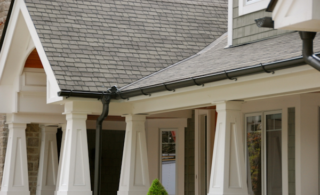 Roofing and Gutter Terms
Roofing and Gutter Terms 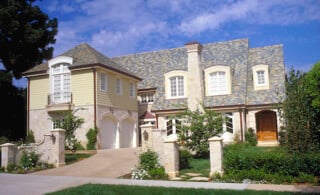 Built Up Roof Basics
Built Up Roof Basics 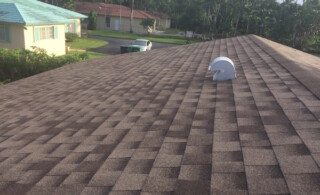 Roofing Shingles Come in All Shapes and Sizes
Roofing Shingles Come in All Shapes and Sizes 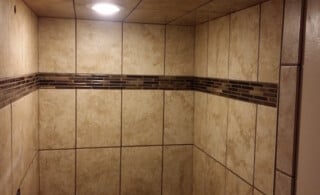 Tile Calculator: How to Calculate the Number of Tiles Needed
Tile Calculator: How to Calculate the Number of Tiles Needed 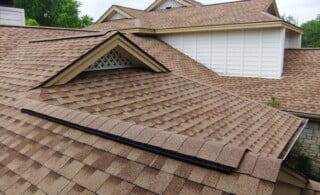 Roofing Area and Shingle Calculator
Roofing Area and Shingle Calculator 

Are You Familiar With This Topic? Share Your Experience.